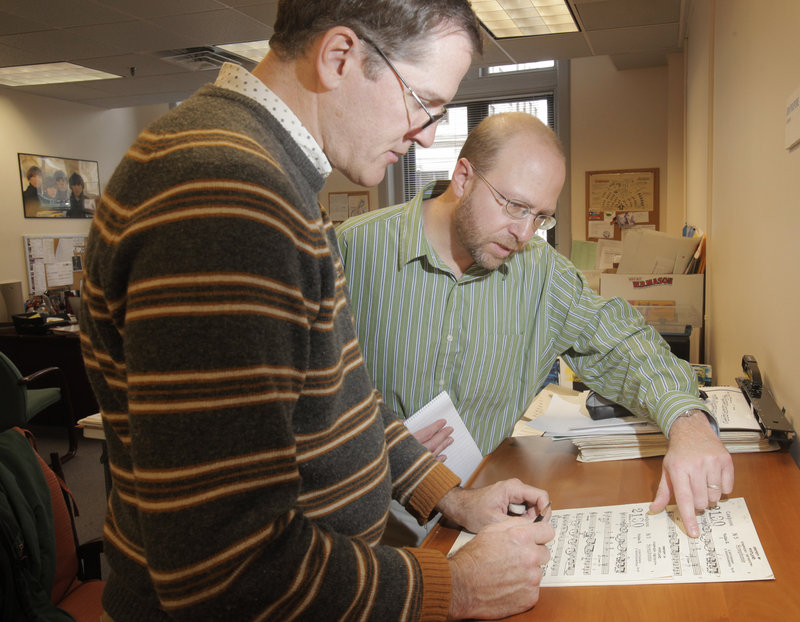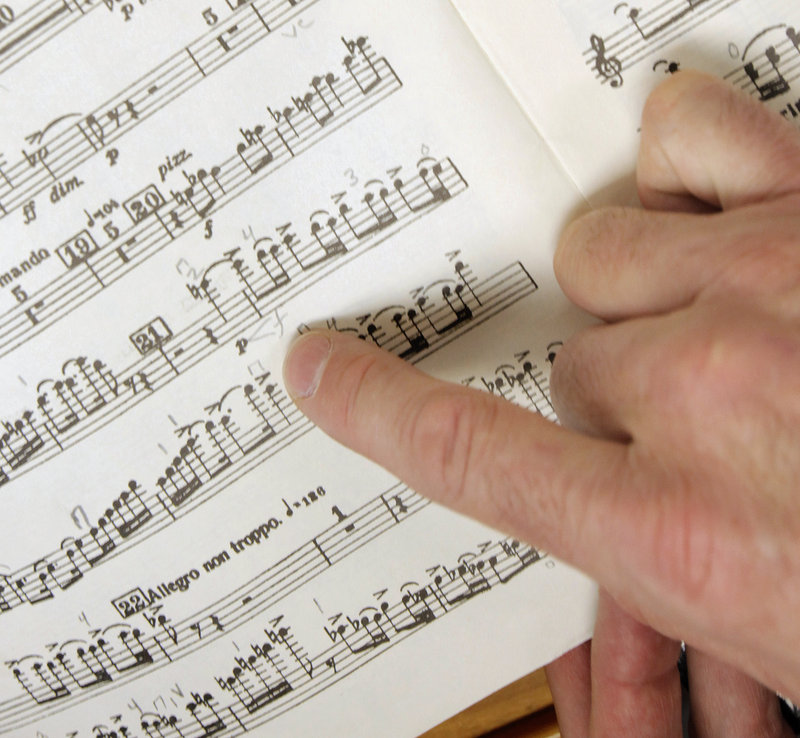PORTLAND – Jon Poupore grabs a stack of sheet music — Shostakovich’s Symphony No. 5 — and tells me he’s going to work on the bowing.
The sheets don’t look bowed or bent in any way, so I’m a little thrown by the term. But Poupore is music librarian for the Portland Symphony Orchestra, so I cleverly figure out it’s got something to do with the bows of string instruments.
“What I’ve got to do is look through all the scores for all the string players, and make sure the bowing is the same,” said Poupore. “That way, all the bows are going up at the same time, and they’re going down at the same time. It’s about the look for the audience, but it’s also about the sound.”
Poupore tells me it’s tradition for symphonies to have their bows flying in the same direction, though he’s not sure why. Some conductors have embraced freestyle bowing, but not many.
Poupore has me grab a pencil and eraser and starts showing me the sheets of music, which have already been marked up somewhat. Some of the marks were made by PSO concert master Charles Dimmick, who is also first violin. Now, Poupore has to read through the sheet music to make sure the bowing — and any other changes — match Dimmick’s.
While he proofreads, he uses his experience as a violinist to make sure all the bowing makes sense.
The trouble is there are many different marks for bowing. A little hill on top of the notes can mean an up bow, a little sling beneath the notes can mean down bow. But a little vertical rectangle with no bottom also can mean down bow, and a little V or check can mean up bow. As I look over all the lines with Poupore, I find that all of the bow marks look a little different.
“See, now that’s an ugly down bow right there,” said Poupore, looking at a very narrow and sort of cursive marking. “If I had time, I would erase some of these marks and make them all clear and neat, so they’re easier to read.”
But he doesn’t have extra time. He works 20 hours a week for the PSO, and he might spend 10 hours proofreading just one piece of music for symphony players. The PSO usually has 60 to 90 musicians in each performance.
When Poupore lets me proof a page, it takes me about five minutes to scan a couple of lines, thinking out loud about whether the up bow symbols and down bow symbols match. I’m also supposed to check for little X marks next to the lines, which indicate that Dimmick has made a change on his copy.
At one point I find a down bow symbol missing on the sheet I’m proofing. I carefully mark one there, remembering what Poupore said about being neat and clear.
“Oh, that’s perfect,” he said.
Of course, I’m not making hundreds of them.
Besides getting the Shostakovich piece ready for an upcoming classical concert, Poupore was working hard on the 11 “Magic of Christmas” concerts scheduled for December. He had a folding table in his office crowded with a dozen or so stacks of Christmas music.
Much of Poupore’s job is administrative. He mails a lot of music back to rental companies, for instance. And he’s in charge of the PSO’s library, a depository of all the sheets of music the symphony actually owns. The PSO began buying music 60 years ago or more, and the collection has never been culled. One of Poupore’s ongoing projects is to cull the collection.
So around midmorning, we leave the PSO offices at 50 Monument Square and walk a few blocks down Congress Street to the PSO’s performance space, Merrill Auditorium. We walk to a space under the stage area, where Poupore uses a key to unlock the library — a fairly small, windowless room with movable shelves and 3,000 pieces of music in large yellow folders.
The folders are all numbered according to when they were purchased, so Poupore is looking at the oldest pieces to check their condition or, perhaps more importantly, whether the music is something the PSO is likely to ever play again.
He builds a pile of worn-out music — many of the sheets are dog-eared or yellowed or torn — that will likely be donated to a college or community orchestra.
“This copy of Beethoven’s Symphony No. 1 is in very poor condition, and it wouldn’t make sense to try to sell it, since you can buy a brand new set for $200 tops,” said Poupore. “So I think we’ll just donate it.”
Poupore comes across some music labeled “Marie Rhines Folk” but has no idea what it is.
There is some beautiful artwork on the sheets, so he decides to keep them, research the piece and figure out if it’s something the PSO might play.
“I just don’t have the heart to get rid of it,” Poupore said.
So he puts it back on the shelf and we move on.
Staff Writer Ray Routhier can be contacted at 791-6454 or at:
rrouthier@pressherald.com
Send questions/comments to the editors.





Success. Please wait for the page to reload. If the page does not reload within 5 seconds, please refresh the page.
Enter your email and password to access comments.
Hi, to comment on stories you must . This profile is in addition to your subscription and website login.
Already have a commenting profile? .
Invalid username/password.
Please check your email to confirm and complete your registration.
Only subscribers are eligible to post comments. Please subscribe or login first for digital access. Here’s why.
Use the form below to reset your password. When you've submitted your account email, we will send an email with a reset code.